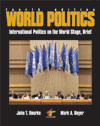North Atlantic Treaty Organization was formed in 1949 to save Western Europe from what many believed to be a threat from the Soviet Union. Then, after NATO had stood guard for 45 years, the USSR collapsed and, thus, the original purpose of NATO disappeared. One might think that NATO would have soon disbanded amid praise for a job well done. Such has not been the case, however. Instead, NATO is undergoing a metamorphosis in which it is expanding both its role and its membership. When this transformation is complete, NATO may well emerge as a Pan-European, multipurpose security organization that little resembles its earlier, cold war character. The first way that NATO has sought new life is by expanding its mission to include peacekeeping (Yost, 1999). The goal, according to NATO deputy secretary-general Sergio Silvio Balanzino (1996:87), is "to move beyond [NATO's] core principle of collective defense" in order to make the alliance "available for collective security tasks such as crisis management and peacekeeping." Bosnia has provided the first test of the alliance's new mission. After several years of internal disagreement and ineffective action, NATO finally moved more resolutely in 1995. Military action by NATO air power against the Bosnian Serbs helped bring them to the peace table. The multinational Implementation Force (IFOR) that moved into Bosnia, and remains there, in accordance with the November 1995 Dayton Peace Accord was essentially a NATO operation. Soon, NATO forces once again found themselves at war and then trying to keep the peace in the Balkans. In this case, Kosovo was the focus of NATO action. It is important to know that the reason NATO intervened was not a military threat to the alliance. Rather, according to Lord Robertson of Port Ellen, NATO's secretary general, there was "a shocking picture of a planned campaign of violence against Kosovar Albanian civilians". Recalling that "it was Edmund Burke who said that for evil to triumph it is only necessary for good men to do nothing," Lord Robertson proclaims, "NATO's 19 nations acted."Between March and June, 1999, NATO warplanes and cruise missiles conducted over 10,000 strike sorties that pummeled targets in Serbia, Montenegro, and Kosovo (all provinces of Yugoslavia) in an effort to force the Serbs to end their attempt to ethnically cleanse Kosovo of its majority Albanian ethnic population. Once that succeeded, approximately 45,000 troops (mostly from NATO, with small contingents from other countries participating in the Kosovo Force, or KFOR) entered Kosovo and remain there to maintain order. The second aspect of NATO's evolution involves expanding its membership. The designation "North Atlantic" is being strained by the admission of states in Eastern Europe. The first step came in 1997 when the annual NATO summit meeting extended a membership invitation to the Czech Republic, Hungary , and Poland. They became members in 1999. Also that year, in the words of a NATO fact sheet" leaders of the member-countries meeting in Washington, D.C., "reaffirmed... their enduring commitment to NATO's Open Door policy, pledging that this round of NATO enlargement will not be the last."1 According to the fact sheet, nine countries ( Albania , Bulgaria, Estonia, Macedonia , Latvia, Lithuania, Romania, Slovakia , and Slovenia) have declared their wish to join NATO, and the alliance intends to "help these states build the strongest possible candidacy for future membership."2 The first round expansion of NATO touched off a heated debate in academic circles, but it did not stir much controversy beyond that realm in the NATO member-countries (Walt, 1998; Perlmutter & Carpenter, 1998). In the United States, for example, the president argued strongly for NATO's expansion; one poll found only 19 percent of Americans opposed; and the U.S. Senate ratified the amendment to the NATO treaty allowing the new members by a vote of 80 to 19 (Goldgeier, 1999- Boyer & Rourke, 1998). The strategic implications of expanding NATO were largely ignored. One of the few senators who opposed the treaty lamented that he had felt "like a voice in the wilderness."3 What remains unclear is what the expansion of NATO's role and membership will mean in the future. The change in role may well mean that American, Canadian, and European forces will engage in more peacekeeping missions, like the one in Bosnia. In this sense, NATO is no longer exclusively, or even primarily, an alliance designed to ward off an outside threat. Instead, at least for now, it is a regional peacekeeping organization dedicated to keeping peace within its region by intervening in civil wars and other internal disturbances. The expansion of NATO's membership also means that the United States and other members are now required to come to the defense of Poland and other states far from the North Atlantic. Nine other countries are seeking admission to NATO, and the inclusion of some of those will bring the NATO (and, therefore, the U.S.) defensive commitment to the very border of Russia. How Americans will react if the need arises to defend Warsaw, Poland, or, for that matter, Tallinn, Estonia, from an invasion by the Russians or some other aggressor remains to be seen. If you had been a member of the U.S. Senate in 1998, would you have voted for the expansion of NATO? Would you vote to allow Estonia, Bulgaria, and other interested countries join in the future? Notes 1. Lord Robertson of Port Ellen, "Kosovo One Year On: Achievement and Challenge," on the NATO Web site at: http://www.nato.int/. 2. The Washington Summit, Fact Sheets: "NATO Summit: NATO's Newest Members," on the U.S. White House Web site at: http://www.whitehouse.gov/WH/New/NATO/fact1.html. 3. New York Times, March 14, 1998, p. A4. |



 2002 McGraw-Hill Higher Education
2002 McGraw-Hill Higher Education